Just put this javascript on the html section of aspx page above head section
<script type = "text/javascript" >
function disableBackButton()
{
window.history.forward();
}
setTimeout("disableBackButton()", 0);
</script>
We need to put it on the html section of the page which we want to prevent user to visit by hitting the back button
Complete code of the page looks like this
<%@ Page Language="C#" AutoEventWireup="true"
CodeFile="Default.aspx.cs" Inherits="_Default" %>
<!DOCTYPE html PUBLIC "-//W3C//DTD XHTML 1.0 Transitional//EN"
"http://www.w3.org/TR/xhtml1/DTD/xhtml1-transitional.dtd">
<html xmlns="http://www.w3.org/1999/xhtml" >
<head runat="server">
<title>Untitled Page</title>
<script type = "text/javascript" >
function disableBackButton()
{
window.history.forward();
}
setTimeout("disableBackButton()", 0);
</script>
</head>
<body onload="disableBackButton()">
<form id="form1" runat="server">
<div>
This is First page <br />
<br />
Go to Second page
<br />
<br />
<asp:LinkButton ID="LinkButton1" runat="server"
PostBackUrl="~/Default2.aspx">Go to Second Page
</asp:LinkButton></div>
</form>
</body>
</html>
If you are using firefox then use instead of onload
If you want to disable back button using code behind of aspx page,than you need to write below mentioned code
C# code behind
protected override void OnPreRender(EventArgs e)
{
base.OnPreRender(e);
string strDisAbleBackButton;
strDisAbleBackButton = "<script language="javascript">\n";
strDisAbleBackButton += "window.history.forward(1);\n";
strDisAbleBackButton += "\n</script>";
ClientScript.RegisterClientScriptBlock(this.Page.GetType(), "clientScript", strDisAbleBackButton);
}
We can also achieve this by disabling browser caching or cache by writing this line of code either in Page_load event or in Page_Init event
protected void Page_Init(object Sender, EventArgs e)
{
Response.Cache.SetCacheability(HttpCacheability.NoCache);
Response.Cache.SetExpires(DateTime.Now.AddSeconds(-1));
Response.Cache.SetNoStore();
}
Doing this,user will get the page has expired message when hitting back button of browser
Demo is :

